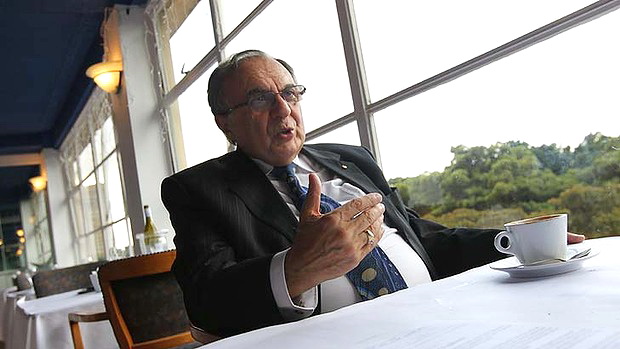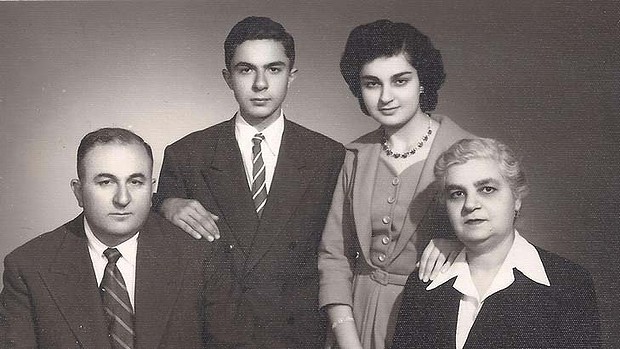


Sada-e-Watan
Sydney ™
sadaewatan@gmail.com



A force for harmony
Saturday, May 11, 2013-Published in Sydney Morning Herald
As he steps down from his official role, the 'hero of multiculturalism' reflects on the remarkable family story that shaped his outlook. Interview by Leading Journalist Mr.Rick Feneley, News and features writer of the Sydney Morning Herald.

The "hero of multiculturalism": Stepan Kerkyasharian. Photo: Dean Sewell
LUNCH WITH DR.STEPAN KERKYASHARIAN
Our window
table is a lovely perch with a view over the canopy of Hyde Park's figs. As the
autumn sunlight streams in to the Hellenic Club, it catches the sheen of a tear
on Stepan Kerkyasharian's cheek. The son of survivors of the Armenian genocide,
Kerkyasharian has made a long career in Australia of building racial harmony. He
is an optimist. But he also has some terrible stories about the worst of human
nature.
He is telling the hardest of them now. It concerns the death of his grandmother.
It is his father's account of watching her die.
''My father,
Manuel, was nine years old,'' Kerkyasharian says. It was 1916. Manuel and his
parents were on a long, forced march out of what today is Turkey. They and
hordes of fellow Armenians were rounded up and deported. Along the way they
witnessed murder, rape, atrocities.
''My grandmother couldn't go on. She asked her husband to carry her to the
river. My grandfather refused. A neighbour carried her on his back and my father
accompanied them. His mother knelt and prayed, and then she jumped in the
river.'' Years later, Manuel would say: ''I looked and the waters carried her
away.''
Kerkyasharian's choice of the Hellenic Club, on the fifth floor in Elizabeth
Street, seems the perfect vantage point from which to survey his remarkable life
and career. He notes the Anzac memorial in the park across the road. He was
raised by his poor refugee parents in Cyprus, where his classmates were Greek,
Turkish, Maronite, Armenian and English. Kerkyasharian and our waiter exchange
pleasantries in Greek, one of his four languages, as he orders the beef
casserole, mosharaki stifado, and requests water rather than wine. I take his
recommendation of baked lamb.
Approaching 70 - and after
almost 25 years at the helm of NSW's Community Relations Commission and its
predecessor, the Ethnic Affairs Commission - Kerkyasharian reveals he will not
seek to renew his contract after September. He has outlasted six premiers, from
Nick Greiner to Kristina Keneally, and has worked happily with both sides of
politics, including with seventh premier Barry O'Farrell, who describes him as a
''hero of
multiculturalism''.
Kerkyasharian has played shuttle diplomat between the politicians and Sydney's
immigrant communities. He has helped extinguish spotfires of racial tension that
at times seemed they would engulf us: following the assassination of Cabramatta
MP John Newman; the first Gulf War; the September 11 attacks; riots at Whitlam
Park and Arncliffe mosque; the Lakemba police station shooting; the Cronulla
riots.
''I've had my share of death threats,'' he says. ''On one occasion I had people
sitting outside my house with balaclavas. Once I was followed over the Harbour
Bridge. Mostly I think it's people letting off steam.''
Kerkyasharian prefers to measure his commission's success by the long absences
of headlines. Foreign diplomats visit it regularly, he says, because they
recognise its vital part in the success of Australian multiculturalism, which is
the envy of the world. To understand his part in that success, we need to go
back to the Cyprus of British colonial rule. Here, young Stepan sewed hemlines
to help his dressmaker mother, Zarouhi. He packed shelves in a shop to pay for
his fees at the English School.
''There were three aisles in our classes,'' he recalls. ''The Greek kids sat on
one side, the Turks on the other, and the Armenians, Maronites, and English sat
together in the middle. It was quite clear segregation, a mini-apartheid. Not a
single teacher ever said I want to mix these children together.''
Some of those Greek and Turkish classmates, he has been told since, became
paramilitaries and then leaders on either side of a bloody conflict. ''Our
school was firebombed a couple of times,'' he says.
The Kerkyasharian home in Nicosia was only 30 meters from the barbed-wire
division between the Greek and Turkish communities.
At 17, in 1960, he bought a plane ticket and, with £10 to his name, moved to
London. It was the year Cyprus gained independence. Under the new constitution,
opportunities for Greeks and Turks were entrenched. The chances of an Armenian
getting a good public service job were ''zilch''.
Stepan studied electronics. He became a manager at a nightclub. He worked in
production engineering for navigation systems. In London, he also met Brenda, an
Armenian girl raised in India. But Stepan had plans to move again.
Back in his school days, a student had brought in a brochure from Trans World
Airlines. Its cover picture, of a turtle on a white-sand beach, had entranced
Stepan. That was where he wanted to live, so he told Brenda: ''I'm going to
Australia. I'm going to become successful and rich, and I'll send for you.'' She
replied: ''No, if you don't take me now, I won't ever come.'' With her parents'
blessing, they married. Stepan was 23, Brenda just 18. It was 1967 and they
boarded a boat for Australia. His parents would follow the next year.
Kerkyasharian would never find that beach with the turtle but, in Sydney, he
joined the Medical Instruments Company and worked on early designs for
electrocardiograms and blood-pressure monitors. He was also making connections
with Armenians, who delegated him in 1968 to answer a call to Canberra. Two
immigration officials informed Kerkyasharian that his people would no longer
need to assimilate. Rather, they could integrate, meaning they could hang on to
their culture. ''Assimilation had been an appeasement - it was spin. Of course,
it failed. Australians soon said, 'They still look funny. They still talk
funny.'''
In the early 1970s, the Whitlam government was to launch a universal healthcare
system but realised it could not reach hundreds of thousands of people who spoke
no English. It used emergency powers to create radio stations 2EA and 3EA - for
ethnic Australia.
''But at this stage, it had nothing to do with multiculturalism,'' Kerkyasharian
says. ''No news was allowed, only music and incessant announcements about
Medibank and how good it was for you. It was only meant to last a few months
but, once they started it, politically it became impossible to shut them down.''
SBS Radio at first broadcast in eight languages, then in another 11, and then in
another 26, including Armenian. For three years, from 1976, Kerkyasharian was
the volunteer host of a weekly show. He later became Sydney station manager,
then SBS's head of radio.
The biggest challenge, he says, was news and bias. Standards could be appalling.
Foreign governments pushing propaganda would provide volunteer announcers with
free packaged programs. ''There was one broadcaster who'd arrive, go to the boot
of his car, bring in the tapes and just let them run. Some of it was offensive;
some would create inter-communal conflict.''
By 1988, he and Brenda had three children. But that year, in a case of medical
malpractice, Brenda died after a hysterectomy. She was only 39.In the same year,
Kerkyasharian became chairman of the Ethnic Affairs Commission.
A Sun-Herald reporter asked him then if he had thought of changing his name,
apparently to make it easier for people to pronounce. ''I said I already had
changed it. She asked, 'What was it before?' I said it used to be Smith.''
A sense of humour would serve him well in his new role. So would a sense of
purpose. That purpose was to engage with communities, to learn their concerns
and to act on them. Following the 1994 assassination of Newman, there was
widespread anxiety about Asian gangs. Months later, with the support of new
premier Bob Carr, ''I went there with my staff. Four of us walked the streets of
Cabramatta … we saw people lining up to buy drugs in front of home units. We saw
people lying on the street, out of their brains, drugged out.''
He recommended a City Watch program, employed a liaison officer to knock on
doors, and ran a forum where tables of 10 residents sat with a police officer
and an interpreter. ''We heard their concerns and went through the list, one by
one. The broken street light was fixed. The dirty creek was cleaned up. Police
would investigate the brothel next door.''
It became a model for connecting with communities. It was the model for dealing
with Indian students when they became the victims of violence. ''Racism is not
something you can let simmer,'' Kerkyasharian says. ''It doesn't simmer. It
explodes.''
On this measure, he says, NSW can be proud as the pioneer of the Community
Relations Commission model. It was in the early and mid-2000s - after September
11, Tampa, the Cronulla riots - that he was less impressed with the response
from federal politicians, on both sides of the fence. ''We got to the point
where political leaders were making statements in support of multiculturalism,
then looking over their shoulder in case someone heard them say it.''
He saw it as a reversion to worst instincts. ''Whether we like it or not, racism
… is part of human nature. It is the mark of a civilisation to rise above that.
And that requires constant political leadership.''

Family: Stepan Kerkyasharian (second left) with his parents and sister in 1959.
It is a point
that brings him back to Manuel, his father. In the early 1980s, at his son's
urging, Manuel taped his account of the genocide - about eight hours of
recordings - on the condition that Stepan not listen to it until after his
death. Manuel died in Sydney in 1996, at 91. Since then, his account has become
a book, selling six print runs in Turkey.
''That has been possible because my father told this story with no hatred or
bitterness. He simply recorded what happened … He always said, 'I should have
died when I was nine. This life is a gift from God.'''
Soon after his mother's suicide, Manuel's father also died on the road. Left
alone and naked - because children had stolen his clothes - Manuel was
approached by some Turkish women. One wanted to kill him but another, ''took the
swaddle off [her] baby and wrapped it around me like a skirt''. She took him to
her home, washed and dressed him.
''To me,'' says Kerkyasharian, ''that is very instructive. A lot of these
enmities, the violence and hatred, are simply generated by the leadership. It is
not the people.''
Manuel spent the next nine years hopping from village to village, working here,
sheltered there, until he found a people smuggler. Ultimately he landed in
Cyprus, reunited at last with one of his four sisters.
Fifteen years ago, Kerkyasharian found ''great happiness'' when he married
Hilda, also of Armenian roots. Three years ago, they visited Armenia for the
first time. ''Now it is time for me to take it a bit easier, to do some
community work.''
And perhaps go searching for that elusive beach with the turtle.